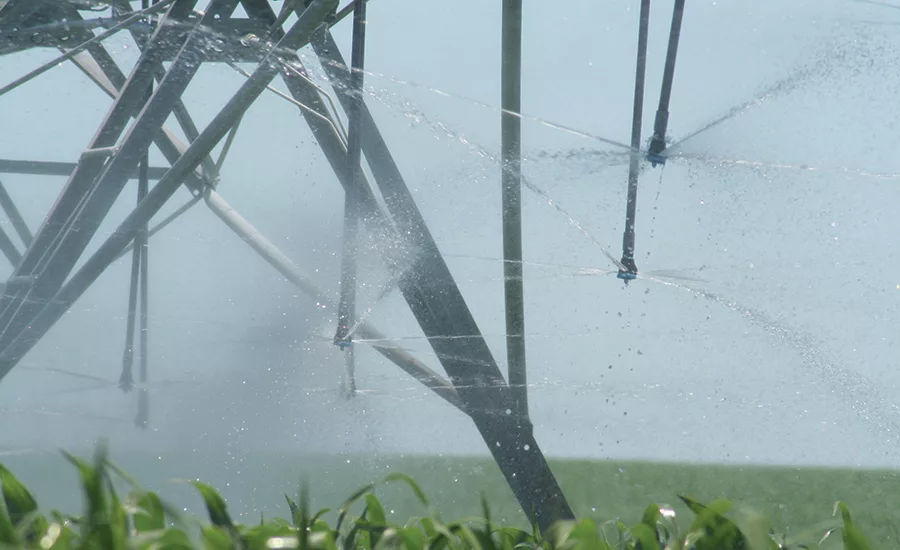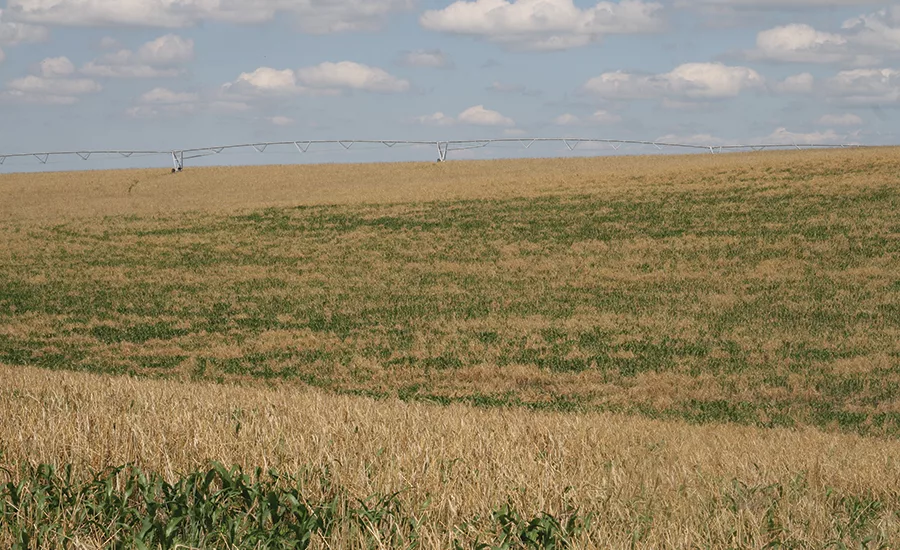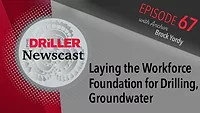The Going Rate for Groundwater
Groundwater Exchanges Help Determine Value, Conserve

Nebraska’s Central Platte Natural Resources District has implemented a temporary exchange program that allows property owners to increase irrigated acres without adding to the region’s overall water consumption. Source: Central Platte Natural Resources District photos


Groundwater rights holders are more likely to sell their rights on a temporary lease basis than they are permanently, says Lyndon Vogt. Source: Central Platte Natural Resources District
Nebraska irrigates the most acres in the country from water wells — 7,875,162 — according to a 2007 Census of Agriculture report. More than 90,000 active irrigation wells were in operation in Nebraska as of August 2007, according to the University of Nebraska Lincoln Institute of Agriculture and Natural Resources. The institute finds that the highest density of wells is located in the Central Platte Valley, where more than 16 irrigation wells have been installed per square mile of land.
At a time when, due in large part to regional drought in the U.S., groundwater sustainability is increasingly at the forefront of government policy and resource management efforts, Nebraska’s Central Platte Natural Resources District (CPNRD) is taking steps to ensure that its groundwater supply and streamflow are not negatively impacted.
Article Index:
In an effort to keep the area from pumping more groundwater over time, the CPNRD enforces a policy of “no new acres,” says Lyndon Vogt, CPNRD general manager. That means that when a landowner wants to irrigate more acres of land than they already are, they can’t implement that addition without the CPNRD making sure that someone else within the region is planning to cut the acreage they irrigate by the same amount.
The CPNRD has approved permanent groundwater rights transfers for more than 10 years, but the district recently launched a new program that allows irrigators to lease water rights temporarily, for just one growing season. “You’re paying someone to leave some ground dry so you can irrigate more acres of your own,” Vogt says.
The Groundwater Exchange Program aims to increase the efficiency of the groundwater exchange process, conserve groundwater and better understand the true value of groundwater. A “water right” is defined by the CPNRD as certified groundwater use on irrigated acres.
How it Works
On March 31, the CPNRD board approved the first transactions of the Groundwater Exchange pilot program. First, the buyers and sellers met with the CPNRD to get approval of where they wanted to add irrigated acres or subtract from them. Next, they were given a bidder identification number, which allowed them to go online, to the Groundwater Exchange Program, and enter how much they desired to pay or be paid per acre. The CPNRD partnered with a private outside consulting firm, NERA, which put together an algorithm that strategically matches buyers with sellers.
“What the seller is doing is saying this is the minimum amount I will accept, and the buyer’s saying this is the maximum amount I’m willing to pay,” Vogt says. “The algorithm will match them up and they will get at least what they’re asking or the water won’t sell.”
Since the March exchange was a pilot program, the number of participants was limited to the first 50 that were pre-approved. Sellers placed 30 locations online for leasing. Six buyers placed bids. The computer program matched the three irrigation bids with sellers in the eastern area of the district. The program is set up so that actors are anonymous, so buyers and sellers do not know who or what location is at the other end of the deal.
Vogt says the three bids that turned into deals ranged from $30 to $60 an acre, which is a range of about $200 to $600 per acre-foot to the river. “The numbers are fairly low for having the ability to irrigate. I mean, $60, as far as I’m concerned, even for one year, is pretty darn cheap.”
With respect to groundwater’s value, Vogt says there isn’t enough information available to get any real sense. “It really is all over the place. We only had three transactions that matched up, so to say that they gave us an idea of the value of water would really be false as far as we’re concerned.”
Stakeholders
The Groundwater Exchange Program allows producers to temporarily hand off water rights they don’t need in a particular year instead of permanently transferring them. “We thought, how can we bring people that have acres together that they don’t want to irrigate or don’t want to mess with, with people that maybe could have more of an efficient system to finish off a field? So there is an efficiency and conservation issue that we’re looking at,” Vogt says.
The majority of the participants in the pilot exchange — both buyers and sellers — were, unsurprisingly, farmers. He says they witness a number of reasons as to why individuals want to lease their acreage, whether it’s because they are odd shaped, hard to irrigate, they include poor soil or the owner is getting elderly and no longer wants the extra work of irrigating.
“But they don’t want to sell them permanently, because once they transfer them off permanently or sell them permanently, that land is dry,” Vogt says. “So they’re losing much more value on a permanent transfer. But on a temporary transfer, it’s just a one-year transfer, so it’s for one irrigation season, one growing season. Then they get that water back.”
He says temporary leasing increases the efficiency of water rights deals because more players are apt to lease their acreage if they know they are still the permanent holder of the water rights. He says aside from farmers, those looking to conserve groundwater can simply lease acres to keep them dry. Whatever the scenario, with more water rights holders willing to lease their property, more exchange occurs and water rights are more likely to be in the hands of those who most need them at any given time.
A New Model
The concept of a temporary water exchange is very new, according to Anastasia Valdes, CEO of the Texas Water Exchange. “There’s not even a trail to blaze yet. We’re really forging in new territory. I think there’s a long way to go on an exchange model. It’s quite reasonable to expect that, in order to have it grow and adapt in function in many states, for it to need 20 years.”
Valdes came up with the idea for that state’s exchange at her kitchen table and it was launched in 2014. Like the CPNRD exchange, it deals with temporary groundwater rights leasing. However, it is a private entity that also oversees permanent water rights transfers and is open to all forms of water — not just groundwater.
She says the “ambitious endeavor” she has taken up is focused on water markets and that the exchange is just one component of a much larger end goal. The goal behind the Texas Water Exchange has been to standardize the contract associated with the transactions. Valdes says being at the center of such deals has given her team the ability to get a strong grasp of the characteristics of those who need water and their motivating factors.
More important to her long term is to capture the price status and value of water. The exchange was a starting point in thinking about a broader water market. “So we also have launched a brand called Water Markets Inc. and that’s the brand that we’re going to carry into the future as we move into other states, because our goal really is to collect and standardize all the price data for all the transactions that happen that are specific to water in the marketplace,” Valdes says. “That enables us to be able to provide valuation services to assist financial institutions to help people use their water rights, for example, as collateral in getting loans; essentially treat the water like you would any other asset class.”
The Texas Water Exchange covers a private region of the Edwards Aquifer and, due to that geography, Valdes says groundwater makes up 100 percent of the deals that have taken place within the exchange. She estimates that the program has done about 250,000 total transactions so far.
Water as an Asset
Valdes says the exchange is offered mostly as a public service that aims to help participants start to recognize water as more of an asset. “We don’t make much money on it. If somebody’s doing a short-term lease in our home town, most of them can do a transaction for less than $100.”
As for factors that impact actual price, she says temporary leases generally cost much less than permanent transactions. “In the Edwards Aquifer region, if you wanted to purchase one acre-foot from somebody who currently has it on the western portion of the region, that’d be $6,000 as a rough average. But if you wanted to lease that same water right, it is feasible if you know your neighbor because there are still a lot of very informal transactions. There are people that are getting in for $70. So there’s a huge price differential.”
In addition, she says she can see weather patterns as being influential on the activity level of the exchange, with participation increasing during periods of drought.
Valdes started the business asking a simple question: “Why is it that water is only on one side of your balance sheet? It’s listed as a cost. You put a lot of money into it. If you’re drilling a relatively modest municipal well, which can cost you $1.5 million, why isn’t the water itself and the water rights themselves listed on the asset side of your balance sheet?”
The company just recently started offering physical appraisal services, including with relation to groundwater, and she says that having a scientific understanding of exactly how groundwater systems flow and function will be crucial for a business model like the one she is working to create. The existing limitations with regard to the understanding of what lies below ground highlight the value of wells, which wouldn’t exist were in not for drillers. “I do know that without wells that are drilled it’s very difficult for us to do the boots on the ground, local observations necessary to really understand flow channels.”
Vogt says the Groundwater Exchange Program could also influence drilling demand. “I suppose we could have some people that are adding additional acres that maybe need a supplemental well. … I’m sure that it’s possible we could have a few wells closed because of this program and it’s possible we could have a few new ones drilled because of this program.”
He says he is pleased with the initial pilot exchange and that it went smoother than anticipated. “It went really well. Our board hasn’t taken a final action on it, but I think our intent is to hold it again this fall and that’ll tell us where we’re at.”
Looking for a reprint of this article?
From high-res PDFs to custom plaques, order your copy today!









